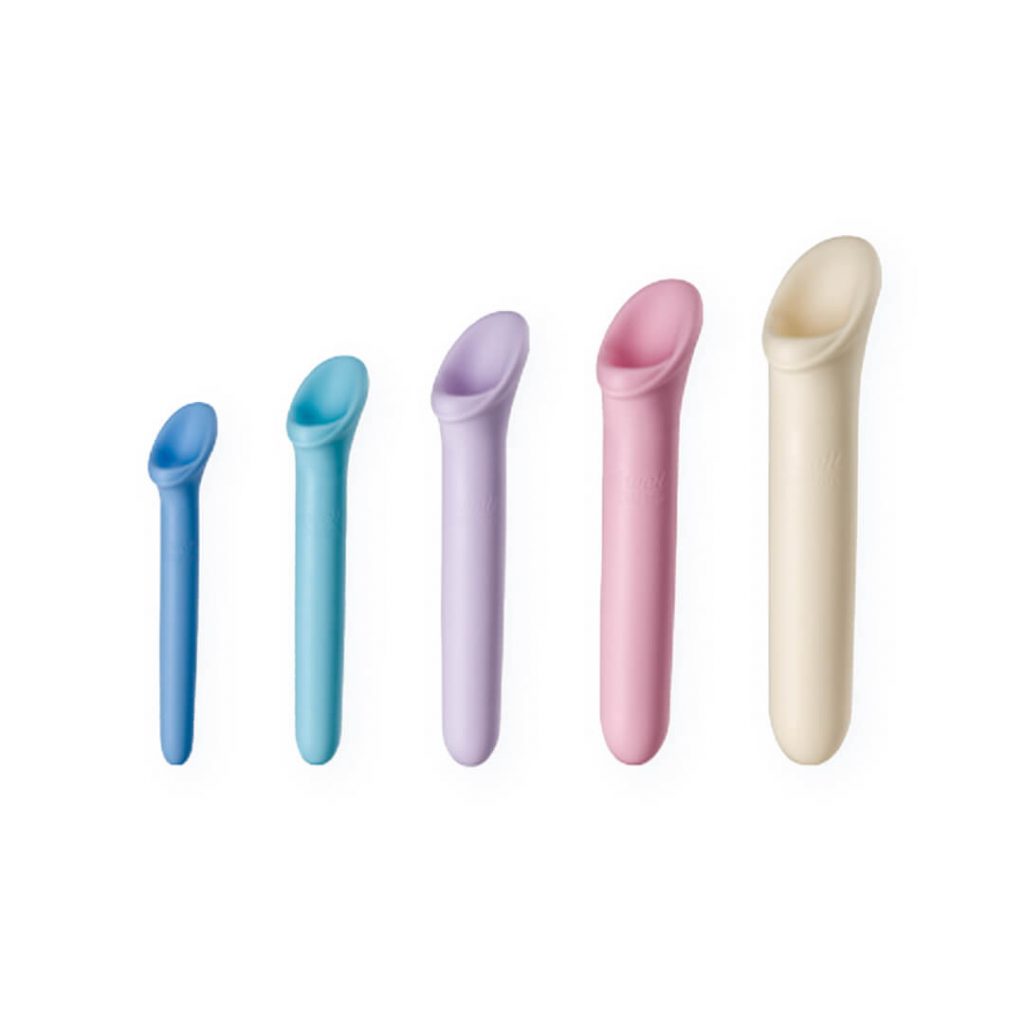There are different types of vaginal complaints where training with dilators can contribute to the solution. These complaints can have both physical and psychological causes. Read more about the different types of vaginal complaints below.
Pain during intercourse
Pain during intercourse (dyspareunia) is common. It’s often thought that this only occurs in women. This is not true; men can also experience pain during intercourse. Both young couples and older couples can experience problems during intercourse. There may be a physical cause, but often it’s a combination of physical and emotional factors.
In women, a distinction can be made between deep and superficial pain during intercourse.
Superficial pain refers to pain that occurs upon contact with the vaginal opening. For example, during penetration and when inserting a finger or tampon. Deep pain occurs during penetration. The pain is caused by the penis hitting the cervix. Some women then feel pain in the lower abdomen.
Physical causes
To be able to have pleasant and pain-free intercourse, the vagina must be moist and both body and mind relaxed. If the muscles around the vagina are tense, this can cause pain. When a woman is unable to insert a penis, fingers, or tampon into her vagina, we call this a vaginistic reaction. The vagina then tenses up unconsciously and involuntarily.
This can have psychological causes, but also physical ones:
- Inflammations, irritations, fungal infections, bacterial infections, or wounds on or in the vagina, labia, or cervix.
- An STD: the balance in the vagina is disrupted, which can cause pain. If you have been at risk of an STD, get tested.
- Due to the position of the uterus, a prolapse, or a position where the penis enters very deeply, the penis can come into contact with the cervix. This pain can be deep and dull or sometimes sharp. These complaints can be persistent. Try to find positions together where the penis doesn’t enter the vagina as deeply.
- Scar tissue or stitches can cause pain.
- Hip problems, such as misalignment of the hips, can cause pain in certain positions.
Consult a doctor with these complaints.
Psychological causes
Pain during intercourse often occurs because you are not relaxed enough. Fear, tension, negative feelings or thoughts, and dissatisfaction can cause pain. This is because you are less able to relax. You become aroused less easily and can end up in a pain spiral.
Negative feelings, insecurity, or fear can arise from:
Unpleasant experiences, such as coercion, sexual abuse, or a previous experience of pain during intercourse. An unpleasant internal examination can also cause fear, shame, or anger.
Negative or incorrect messages from upbringing about your own body or sex, such as “sex is sinful” or “masturbation makes you blind”. You may then not be able to enjoy sex freely because you experience guilt, shame, and insecurity.
Pain during intercourse is often difficult to solve on your own. So don’t keep struggling with it. Go to your doctor and bring it up. If your doctor can’t help you further, consider seeking help from a sexologist. They are specialized in treating complaints such as pain during intercourse.
Practicing with a dilator set like Vagiwell can contribute to effective treatment.
Lichen Sclerosus
Lichen Sclerosus (LS) is a skin condition, particularly affecting the labia, around the vagina, and sometimes around the anus. The skin becomes white and thin. Small tears can develop, causing the main symptoms of itching and pain. Lichen sclerosus mainly occurs in women. It usually starts between the ages of 45 and 60. Sometimes the disease also occurs in adult men and occasionally in children (more often in girls than in boys). When a girl or boy has Lichen Sclerosus, it is called pediatric LS.
Changes that may be visible in the skin include:
– Skin becoming lighter or whiter
– Skin becoming thinner
– Small tears
– Small bruises or blood spots
– Scarring: the skin shrinks and the vaginal entrance becomes tighter
LS usually appears symmetrical on the left and right sides, creating a figure-8 pattern on the skin. This is visible around the entrance of the vagina and anus.
The disease occurs on the:
- Inner labia
- Outer labia
- Clitoris
- Vaginal entrance (introitus)
- Anus (perianal)
- Trunk (upper part and around the navel)
- Scalp, palms, and soles (this is rare)
- On the penis in men
Do you recognize these symptoms? If so, contact your general practitioner.
Training with Vagiwell dilators can be helpful in keeping the vagina open and flexible. Always discuss such training with your treating physician before starting.
Vaginismus
Vaginismus or vaginistic complaints occur when a woman cannot or has difficulty inserting a penis, finger, or tampon into the vagina, even though she wants to. The cause is an unconscious tensing of the pelvic floor muscles surrounding the vagina.
In some cases, there has always been a vaginistic reaction. In others, the problem developed later, after previously being able to have sexual intercourse.
Vaginismus can develop as a result of pain during intercourse. The reaction can occur in various situations: during attempts at sexual intercourse or when inserting a tampon or finger.
Treatment of vaginismus
Vaginismus can make a woman feel insecure and can lead to tensions in the relationship. Vaginismus is treatable. It is advisable to discuss these complaints with your general practitioner or sexologist. The therapy can be supported with pelvic floor exercises, relaxation exercises, and training with a dilator set like Vagiwell. The Vagiwell dilators are not intended to stretch the tissue in vaginismus, but to gradually relax and allow the increasing volume of the dilator.
Vaginal agenesis
Vaginal agenesis is a rare congenital defect where the vagina is missing or only partially developed. The condition is usually detected at the onset of puberty when the first menstruation fails to occur.
This condition can be treated with Vagiwell, which repeatedly applies pressure to the vaginal entrance. The dilators vary in size. Over a period of six to eight weeks, the vaginal entrance can be stretched to sufficient depth.
If this method does not yield results, a vagina can be surgically constructed. This is called vaginoplasty. Regular exercise with a dilator set is also necessary after this procedure.
Vaginal stenosis (narrowing)
Radiation therapy (radiotherapy) around the vaginal area often leads to narrowing or adhesion of the vagina. The medical term for this is vaginal stenosis. The same complaints can arise from scarring after vaginal surgery.
After the radiation treatment or surgery, vaginal dilators are usually used to keep the vagina flexible and prevent scar tissue formation. Vagiwell is an excellent choice.
Male to female transgender surgery
In gender reassignment surgery from male to female, a new vagina is constructed from the penis and other tissue through surgery. After this procedure, it is necessary to regularly practice with a dilator set such as Vagiwell.
This prevents the newly formed vagina from closing or becoming too narrow. If possible, these exercises should be performed twice a day during the first year after surgery. Follow the instructions of your doctor or physiotherapist for the best results.

